Basic Challenges:
Stellar and Galactic Evolution:
Stars evolve based on what we see from the HR diagram. That should mean that the basic material which forms the universe appears to be changing. Mostly it's still hydrogen but the evidence is that there is getting to be more and more heavier stuff as the universe ages around us. If the universe has been here 'forever' this raises some inconsistencies.
As we look back in time (in some cases we're looking at galaxies formed billions of years ago) we start to see differences in the make up of galaxies formed long ago compared to those now. This also suggests that the universe evolves and is not static over long periods of time.
Hubble Flow:
We discussed Hubble's observation that the further a galaxy is from us the faster it appears to be running away (receding). Hard to come up with a great explanation for that. It is even worse when you realize that it doesn't matter which direction we look all the galaxies in EVERY direction seems to be running away from us in the same way. This observation is very challenging to explain.
Cosmological Principle:
One important question that needs to be addressed in all of this is whether our part of the univese behaves any differently than any other part of the universe. Do the rules that seem to govern how gravity and light and other physics stay the same as I go elsewhere in the universe or might they change? How you address the challenges stated above depends a great deal on your answer to this question.
The perspective that science has taken is, absent some compelling evidence, we will assume that the universe is a relatively uniform place where the 'rules of physics' are the same everywhere. It must be admitted that this is partly a self serving choice since assuming the rules might be different everywhere sort of makes it impossible to do science!
Expanding Universe:
If we accept the cosmological principle (that we are not special) then that means we are also saying that every other galaxy sees all the other galaxies (including us) running away from them. After spending too long searching the web for a good visualization of a possible explanation I'm going to have to make do with words. [make the video Bruce!]
Imagine a long line of people standing 1.00 m apart (arms length). Now imagine that each second EVERYBODY gets 0.1 m further apart. We are expanding the space between people. Notice that this means that while the people next to you get 0.1 m further from you the people on the other side of them must move 0.2 m further away in the same moment of time. The further from me you are the faster you seem to be running away. On the other hand EVERYBODY sees the same effect. Take this same idea into 3 dimensions and you have our potential explanation for the Hubble flow.
Granted, this idea of an expanding universe introduces some new questions to worry about but at least this explanation is consistent with the data and the cosmological principle.
Activity: What do you think are some of those new questions referred to above?
What happens next?
Once you have a basic model then science makes an effort to explain what we see based on that model. At the same time science hopes that the model will lead to predictions of things that we hadn't noticed or thought to look for yet.
If we have a model of the universe as expanding as time passes then what happens as you roll the process backwards in time in large steps?
Step 1: Galaxies are closer together stars are younger on average (less time for long lived stars to form)
Step 2: Galaxies are so young that there may be no heavy elements and probably no rocky solar systems. Lots more unformed gas in the universe. Things are getting a little warmer because all things that we compress (make smaller) heat up.
Step 3: Universe is much more compact and much hotter. Perhaps only a few galaxies or stars have formed. Lots of hydrogen around that will form the galaxies and stars but not much else because there hasn't been much chance to convert Hydrogen to other elements in stars.
Step 4: All the gas that will eventually form galaxies and stars is in one large very hot mass (is this just a ginormous star? How hot would this be?).
Step 5: All the stuff in the universe must be so concentrated and hot that all matter as we currently know it is ripped apart into it's constituent parts. What do we know about this state of matter? (This is where particle physics and the CERN collider become part of the discussion).
Step 6: The ultimate beginning -- some remarkable amount of energy in one small space at unimaginable temperature and density.
Step 7: Is there a before that?
This conceptual sequence suggests that we need to understand very hot compact bundles of energy that seem likely to have been present in the early universe. This is the domain of particle physics. Enormous amounts of energy concentrated in very small spaces. As we come to understand how this environment behaves perhaps it will make predictions about a universe that would grow from it.
Particle Physics:
To explore the states of matter that may have existed in the early universe we currently use particle accelerators like CERN on the French-Swiss border. Here is what is looks like from the air. The main circular structure is 100 m underground and about 8 km in diameter.
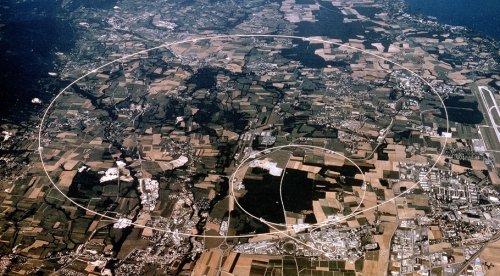
Inside the tunnel are tubes within tubes that carry and accelerate the very high speed particles (usually protons which are hydrogen nuclei) to nearly the speed of light.
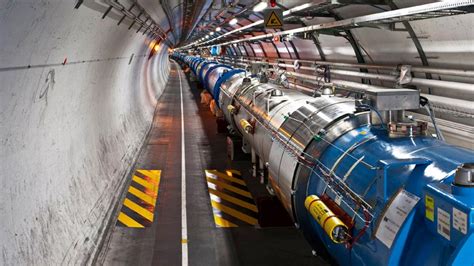
Once they particles reach the desired speed two beams are redirected to that they collide with each other in an enormous detector. Below is the ATLAS detector.
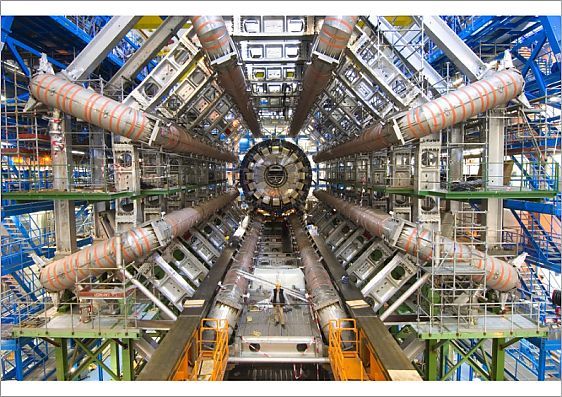
In that detector many particles are created and destroyed as the massive amounts of energy cascade through a series of particles and possibilities. From that large data set we seek to understand the rules that lead to the creation of particles like hydrogen in the early universe.
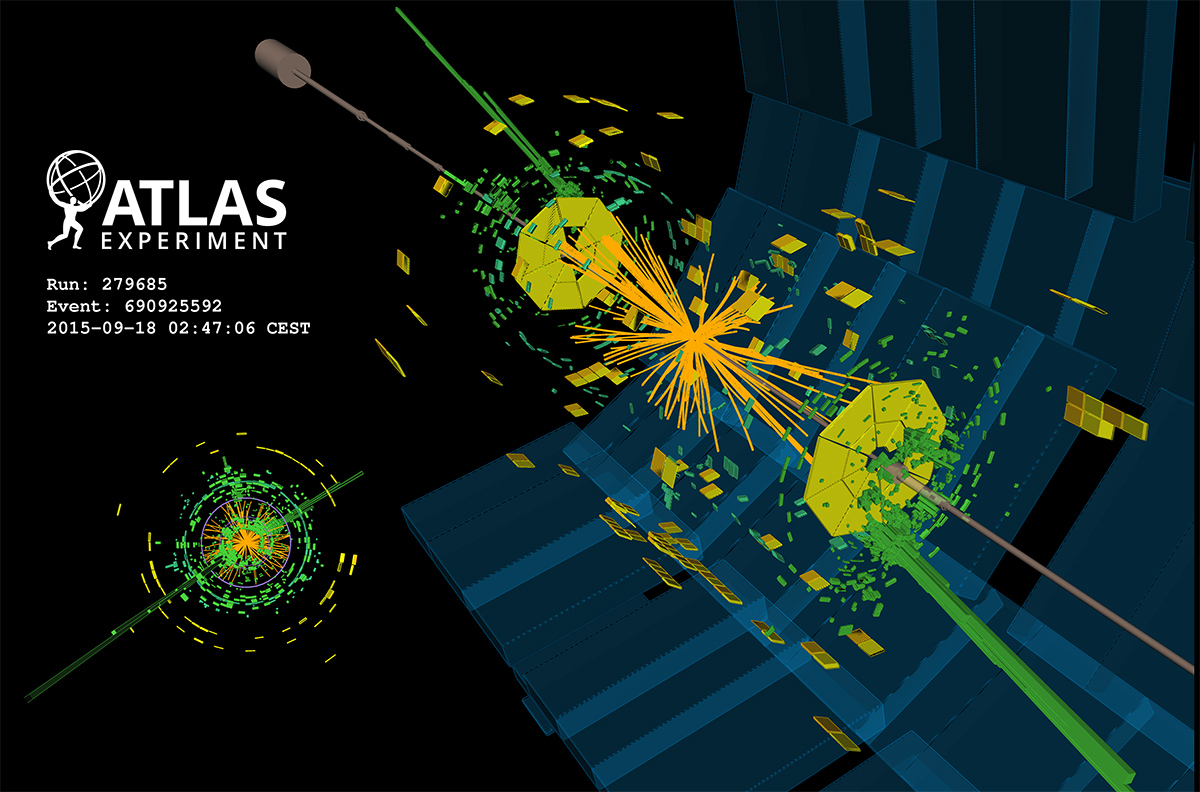
Observations and Data:
Hubble Flow:
The most simple model of an expanding universe is just to run things backwards at the rate defined by the Hubble flow until everything is at a single point. If you were to look at the units the inverse of the slope of the Hubble flow is the age of the universe. For a long time the data was uncertain enough (remember the challenges with the distance ladder?) that we weren't sure whether to imagine the universe as 10 Gy or 20 Gy (gigayears) old. Eventually the data settled and the current agreed upon value is about 13.8 Gy. That would all be lovely but recently we have observed a single star that we believe is 14.5 Gy old. This is a bit of a problem that has not been fully resolved.
Abundances of Hydrogen/Helium/Lithium
Because of the work at CERN and other particle accelerators we are able to predict what we would expect the abundances of the three simplest atoms would be in the early stages of the universe.This predicition depends on many factors but the upshot is that our prediction seems to correlate remarkably well with what we observe when we look at the furthest away galaxies (the furthest back in time).
An additional prediction from our current knowledge of particle physics is that there would be a moment at which the early universe would go from being opaque like the inside of the sun to relatively transparent. Any light that was moving about that early universe would still be visible today although at dramatically longer wavelengths/lower energy. This lead to the prediction that there we might be able to see the remnant glow from that original fireball. This leads us to our next important observation - the cosmic microwave background.
Cosmic Microwave Background:
Here is the background for the prediction and observation of the Cosmic Microwave Background..
" The existence of the CMB radiation was first predicted by Ralph Alpherin 1948 in connection with his research on Big Bang Nucleosynthesis undertaken together with Robert Herman and George Gamow. It was first observed inadvertently in 1965 by Arno Penzias and Robert Wilson at the Bell Telephone Laboratories in Murray Hill, New Jersey. The radiation was acting as a source of excess noise in a radio receiver they were building. Coincidentally, researchers at nearby Princeton University, led by Robert Dicke and including Dave Wilkinson of the WMAP science team, were devising an experiment to find the CMB. When they heard about the Bell Labs result they immediately realized that the CMB had been found. The result was a pair of papers in the Astrophysical Journal (vol. 142 of 1965): one by Penzias and Wilson detailing the observations, and one by Dicke, Peebles, Roll, and Wilkinson giving the cosmological interpretation. Penzias and Wilson shared the 1978 Nobel prize in physics for their discovery."
from Universe 101, NASA WMAP information
The basic idea is that once light is set loose in an expanding universe it must stretch out and cool which changes it from it's original spectrum to a 'cooler' one. Here is some recent data showing the measurements of the spectrum and the predicted shape of the spectrum. The remarkable agreement between the data and the prediction is considered to be one of the core confirmations of the Big Bang model of the universe.
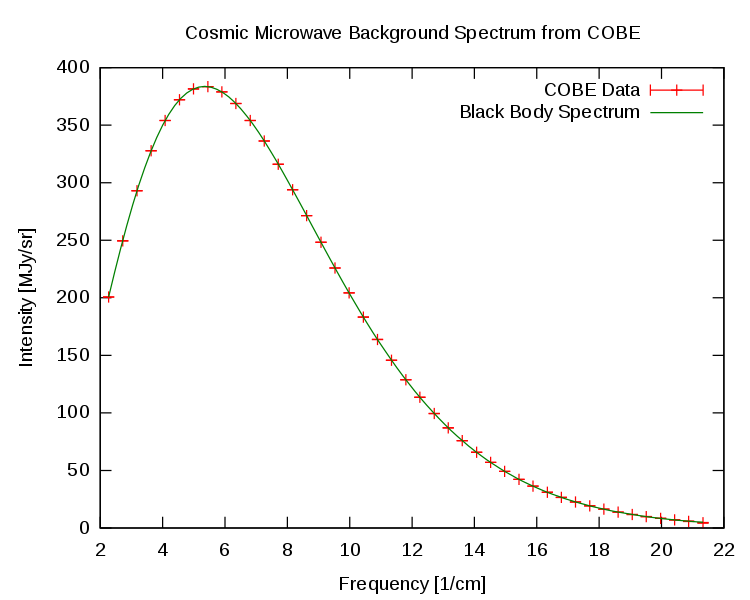
If you look at the spectrum in different directions in the universe you can map the temperature and it's difference from the average spectrum shown above.
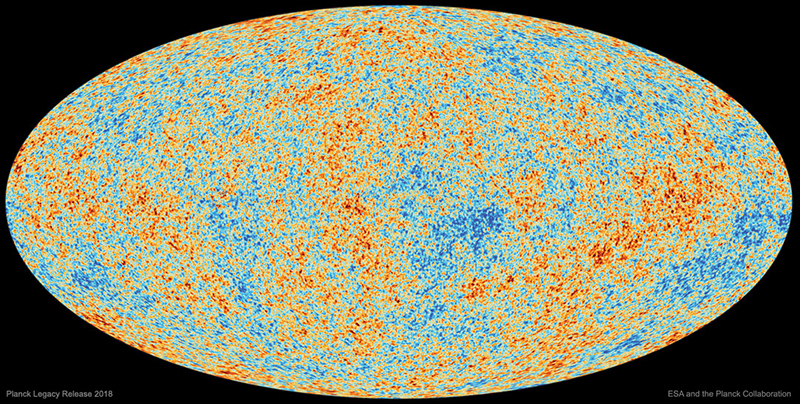
This gives us a sense of how uniform the universe was at this point in it's evolution.
The Problem with Uniformity:
As you have noticed a lot of what we do in astrophysics these days is create large simulations of what we would expect to happen under different circumstances. Here's another short simulation of the formation of a large galaxy from the gases distributed through an early universe. It's lovely to watch but the thing I want you to think about are the assumptions that we have to make about how lumpy the original universe needed to be for galaxies to form in the time we think is available. It turns out if we make the original universe too smooth we wouldn't expect to see any galaxies today. The problem is that the CMB suggests a universe that was too smooth in just this way. We're still working on this challenge. The key point is that without the computational power we have available today we would never know about this problem.
Current Model:
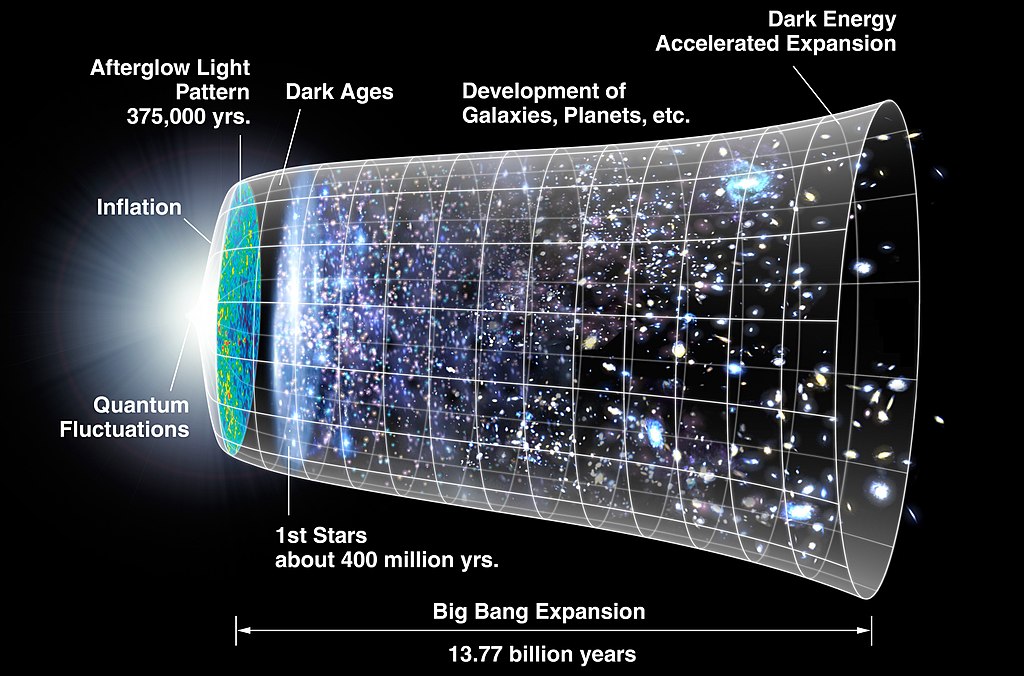
We spent some time talking about how this graphic both helps illustrate our current models of how the universe is developing and at the same time suggests things that aren't consistent with that model. One the the core things to recognize about this graphic is that it suggests that over the roughly 14 billion years of our universe it has expanded by just a few percent (the slowly growing size of the funnel). I haven't seen a version of this graphic with actual scales on it but even if the scales (vertical and horizontal) are log scales there are problems. Another challenge is that this graphic implies an edge to the universe which is also not consistent with our current models. This is not the fault of the graphic since there is no way to show and expanding edgeless object on a piece of paper -- not an option! Still, it is useful in capturing the different stages of a hot big bang model from the early inflation to current times. It also suggests one of the current puzzles which is the acceleration of the expansion in current times.
Cosmology: Another Representation
The graph below (thanks to Ethan Siegal on Medium) is perhaps a more useful representation of our model of the expansion of the universe.
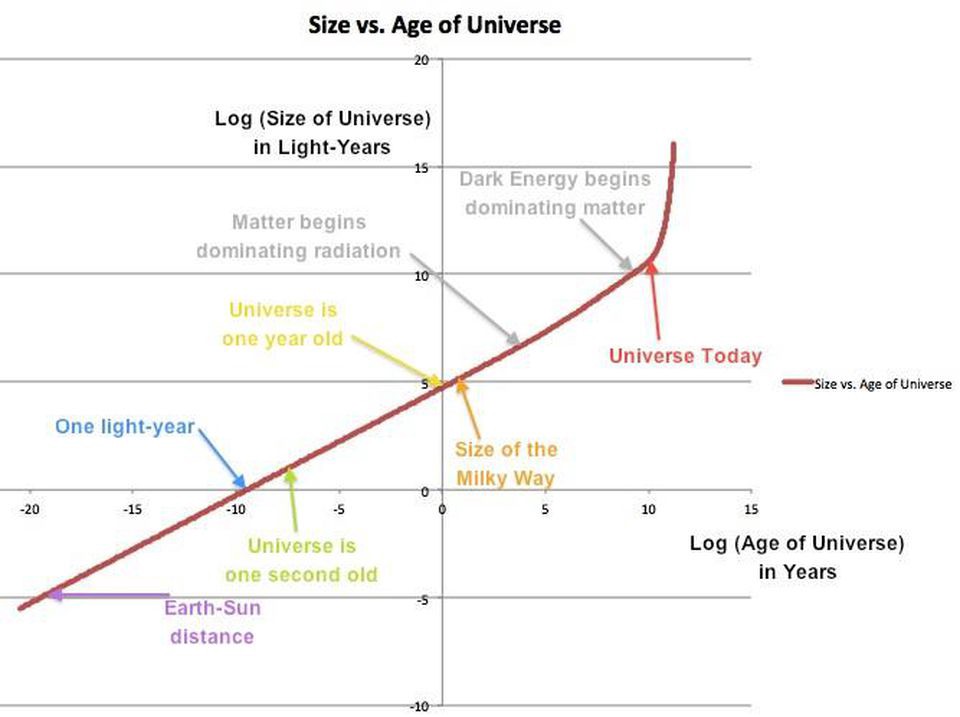
This graph benefits from lots of thought.....consider the log scales on both axes and what that means about the changes represented. There's a lot here that we will try to talk about.
Heres another fascinating perspective on the expanding universe model:
Lots of Reading is possible:
Because cosmology seems to be a basic human interest there is a lot of writing about it. I will link various articles that I find as part of this discussion here.
Forbes: Ethan Siegal -- this is a good summary of the current state of the models for the beginning of the universe.
Where Are We Going?
You'll have noticed that all of the previous discussion is an effort to understand where this universe started and how it got to this point. The question of where it's going is much less clear. Much of that lack of clarity is because there are all the uncertainties in the models for how we got here. Until we have a better grip on dark matter and/or dark energy it's hard to project where we are all going.
A Core Challenge:
Perhaps the most important challenge, at the moment, in any discussion of where the universe is going is the question of whether the expansion is speeding up or slowing down or neither. It is helpful to think of this analogy. If you throw a ball away from the earth there are basically 3 possible outcomes. It can be going fast enough that it eventually escapes from our solar system and goes outwards forever. It might be going not quite fast enough so it gets slowed down to a stop and then dragged back to the earth. Finally it might be balanced on the knife edge between those two options. All those make a certain kind of sense. What would be truly puzzling is if after we through the ball upwards we discovered it was speeding up. That would mess with a lot of our understandings and would require some serious rethinking. Not surprisingly, because apparently the universe loves a good joke, that is what is happening according to the most recent data. The spreading out of the universe appears to be speeding up which is something we have no good explanation for.
So where will this all lead? There are two basic options and then a couple of wild ideas. The two basic options could be characterized as fire and ice. I like to think of them as the "Lets burn it down and try it again!" version and the "Cold, dark whimper" end of the universe. In the "Cold, dark whimper" version we keep spreading out and getting further and further from any other matter until slowing all the stars in the sky die and are not reborn. We can no longer see any other galaxies as they are too far away. Like an endless lonely night everything just shuts down leaving a universe devoid of light or structure -- whew! In the "Lets burn it down and try it again!" version the expansion slows and then reverses drawing everything in the universe back together. In the process everything heats up and comes apart into raw energy like, but not like, a giant fireball. It's possible that our universe is the result of multiple cycles through such a process. This would seem very interesting as a cyclic model of the universe. Unfortunately it's not consistent with our current observation that the expansion of the universe is speeding up.
There are a number of more speculative models that have been proposed though we have almost no evidence to explicitly support any of them. There is a model called 'vacuum decay' which suggests that perhaps space is more unstable than we think and if we expand enough that instability could create a bubble in space that would consume our universe like a black hole perhaps recreating a new universe with the energy sucked from this one. Alternatively there is a model known as the 'big rip' that suggests that if something is being added to our universe to create the acceleration we observe perhaps it will eventually lead to the tearing apart of everything in the same way that it drives the galaxies apart ever faster. Both are very dramatic but very preliminary.
Best Guess?
If you were to talk to a bunch of physicist and astronomers I suspect that you one find that the version most lean towards is the 'Cold, dark whimper' version. That doesn't mean it's right but it is perhaps somewhat more consistent with the data at the moment. We should be careful to note that just 50 years ago the cyclic "Lets burn it down and try it again!" model would have been the majority choice and 50 years before many believed the data suggested a static and unchanging universe that had always been and would always be. The cool, and important thing about science is that it tries to follow the data where it leads.
HW: Cosmology Challenges
Which data (evidence) do you think most supports a sense that science understands at least something about how the universe works?
HW: Cosmology Challenges
Of the many aspects our current ideas about the evolution of the universe which do you find most intriguing and why?
HW: Cosmology Challenges
Of the many aspects our current ideas about the evolution of the universe which do you find most troublesome and why?
Assignment: HW: Cosmology Challenges
Complete and assemble your solutions to all the HW problems listed here. Scan to a pdf and turn in on LMS. Please review HW format expectations for guidance about your homework solutions.
Reading Ahead:
Next time we will continue our explorations of the solar system on the Cosmology II breadcrumb. This will support our discussion about the evolution of our universe.
